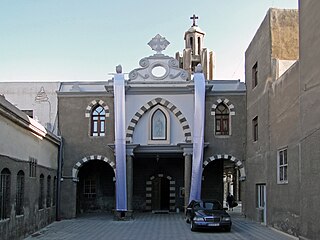Related Research Articles

In Christian denominations, an archbishop is a bishop of higher rank or office. In most cases, such as the Catholic Church, there are many archbishops who either have jurisdiction over an ecclesiastical province in addition to their own archdiocese, or are otherwise granted a titular archbishopric. In others, such as the Lutheran Church of Sweden, the title is only borne by the leader of the denomination.

The Syriac Catholic Church is an Eastern Catholic Christian jurisdiction originating in the Levant that uses the West Syriac Rite liturgy and has many practices and rites in common with the Syriac Orthodox Church. Being one of the twenty-three Eastern Catholic Churches, the Syriac Catholic Church is a self-governed sui iuris particular church, while it is in full communion with the Holy See and with the entirety of the Catholic Church.
A titular see in various churches is an episcopal see of a former diocese that no longer functions, sometimes called a "dead diocese". The ordinary or hierarch of such a see may be styled a "titular metropolitan", "titular archbishop" or "titular bishop", which normally goes by the status conferred on the titular see.

The Latin patriarch of Antioch was a prelate of the Latin Church created in 1098 by Bohemond I of Taranto, founder of the Principality of Antioch, one of the crusader states.
A titular bishop in various churches is a bishop who is not in charge of a diocese. By definition, a bishop is an "overseer" of a community of the faithful, so when a priest is ordained a bishop, the tradition of the Catholic, Eastern Orthodox and Oriental Orthodox churches is that he be ordained for a specific place. There are more bishops than there are functioning dioceses. Therefore, a priest appointed not to head a diocese as its diocesan bishop but to be an auxiliary bishop, a papal diplomat, or an official of the Roman Curia is appointed to a titular see.

Nusaybin, historically known as Nisibis or Nesbin, is a city and the seat of the Nusaybin District of the Mardin Province in Turkey. The city is populated by Kurds of different tribal affiliation and had a population of 84,445 in 2021.
Mariamme was a city in the late Roman province of Syria I, corresponding to present-day Qal'at El-Hosn or Krak des Chevaliers.

Suruç is a rural district and city of Şanlıurfa Province of Turkey, on a plain near the Syrian border 46 kilometres (29 mi) southwest of the city of Urfa.
Dometiopolis was a city of Cilicia Trachea, and in the later Roman province of Isauria in Asia Minor. Its ruins are found in the village of Katranlı, formerly Dindebul.

The Eparchy of Lungro is a eparchy (diocese) of the Italo-Albanian Catholic Church, Eastern Catholic sui iuris of Byzantine Rite in Calabria, Italy.
Marcopolis was a city in the late Roman province of Osrhoene. It is described at the beginning of the 7th century by the geographer George of Cyprus.

The Roman Catholic Metropolitan Archdiocese of Chongqing (Chungking) is a Latin Metropolitan archdiocese located in southwestern PR China, yet still depends on the missionary Roman Congregation for the Evangelization of Peoples.
This is a historical list of all bishops of the Catholic Church whose sees were within the present-day boundaries of the United States, with links to the bishops who consecrated them. It includes only members of the United States Conference of Catholic Bishops and their predecessors.
Camuliana, Camulia, Kamoulianai, or Kamoulia was an ancient town or perhaps a village in ancient Cappadocia, located northwest of Caesarea, today Kayseri in Turkey. It is mostly mentioned in connection with the Image of Camuliana, an acheiropoieton or "icon not made by hands" of the face of Christ, which was one of the earliest of this class of miraculously created icons to be recorded; this is also sometimes referred to simply as the "Camouliana". During Byzantine times, the town was also called Iustinianoupolis Nova.

The Syriac Catholic Patriarchal Eparchy of Beirut is a Syriac Catholic Church ecclesiastical territory or eparchy of the Catholic Church in Lebanon. The Syriac Catholic Patriarch of Antioch's cathedra is found in the eparchy in the episcopal see of Beirut, the capital of Lebanon.

Pierre Lambert Ledrou, O.E.S.A. was a Roman Catholic prelate who served as Titular Bishop of Porphyreon (1692–1721).
The Armenian Catholic Eparchy of Sainte-Croix-de-Paris is an eparchy for the faithful in France of the Armenian Catholic Church sui iuris, which uses the Armenian Rite in Armenian, in full communion with the universal Pope of Rome.
Carlo Francesco Airoldi (1637–1683) was a Roman Catholic prelate who served as Titular Archbishop of Edessa in Osrhoëne (1673–1683), Apostolic Nuncio to Venice (1675–1683), Apostolic Nuncio to Florence (1673–1675), and Apostolic Internuncio to Belgium (1668–1673).
Constantia or Konstantia was a town of some importance in the province Osrhoene in Mesopotamia, on the road between Nisibis and Carrhae, at no great distance from Edessa. It was, after his departure from Nisibis, the residence of the dux Mesopotamiae until the foundation of Dara. There is considerable variation in different authors in the way in which the name of this town is written and the names under which it is known, including: Constantia or Konstantia (Κωνσταντία), Constantina or Konstantina (Κωνσταντίνα), Antoninopolis, Nicephorium or Nikephorion (Νικηφόριον), Maximianopolis (Μαξιμιανούπολις), Constantinopolis in Osrhoene, Tella and Antiochia Arabis, Antiochia in Mesopotamia and Antiochia in Arabia.
References
- 1 2 Annuario Pontificio 2013 (Libreria Editrice Vaticana, 2013, ISBN 978-88-209-9070-1), p. 880
- 1 2 Sophrone Pétridès, "Dansara" in Catholic Encyclopedia (New York 1908)
- ↑ Dausara (Titular See)
- ↑ Dansara (Titular See)